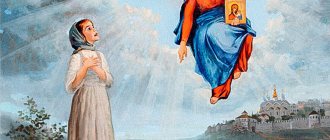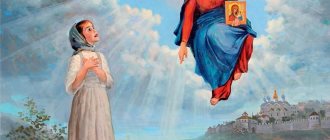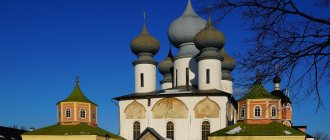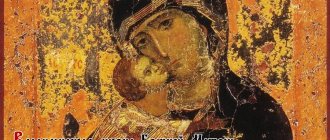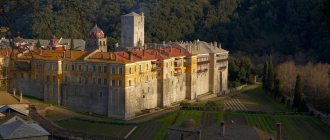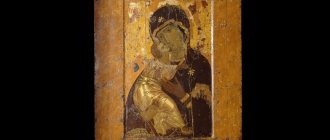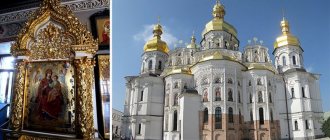The iconography of the Blessed Virgin is striking in its diversity. And this despite the existence of fairly strict canons, without compliance with which the image of the Mother of God will be considered just a painting, albeit on a theological theme!
The Icon of the Mother of God “Tenderness” is perhaps the most lively and reverent reflection of the Virgin Mary and Child. At one glance at her, you feel the depth of maternal and filial love, because despite the Divine essence, Jesus was once a baby and needed his mother’s affection.
The history of the acquisition of the icon, its types and description
The vast majority of Tenderness icons belong to the canonical iconographic type of Eleus (“merciful”). In the Greek tradition, this type is more often called Glykofilusa (“sweetly loving” or “sweetly kissing”).
Some researchers consider Eleusa to be a subspecies of another iconographic type of the Virgin Mary, Hodegetria. However, the Tenderness icon looks somewhat different and awakens different feelings in believers.
The Evangelist Luke himself is considered the discoverer of the Hodegetria type. He personally knew Mary and painted her face virtually from life. So the first images of this type appeared already two thousand years ago, at the dawn of our era!
Scientists believe that Eleusa separated from Hodegetria around the 9th-10th centuries. In any case, the first image of the Eleus type that has come down to us is a rock fresco in the Tokali Kilis temple (now in Turkey).
Images like Eleus - rock frescoes in the temple
In the 11th century, the Mother of God was increasingly painted in the type of Eleusa. Around the same time, the first Tenderness icons appeared in Rus' and gradually became the most beloved among icon painters. In fact, the appearance of Eleusa coincided with the birth of Russian Orthodoxy.
Origin story
“Gerontissa” is the name of the icon, which depicts the Virgin Mary praying to the Savior in full growth. This most holy image is also called “Elderwoman” or “Abbess”. The shrine is kept in the Pantokrator Monastery, which is located in Greece on the most holy Mount Athos, on a rocky hill near the sea.
Several miracles are associated with this icon, allowing Christians to consider the image truly miraculous. Even during the construction of the monastery, tools left by workers in one place were found in another in the morning. This happened several times until people realized that it was the Mother of God herself who was showing them the place where they needed to build a monastery.
The monastery itself is dedicated to the Transfiguration of the Lord. Built approximately between the 11th and 14th centuries. As a gift from the Byzantine nobility, Pantocrator received the icon “Gerontissa”, which depicted the Blessed Virgin, spiritually presiding over the monastery. This most holy image patronizes the elderly. There is even a legend according to which the icon once came to the aid of the dying elder abbot. Before his death, the abbot asked the priest to read the divine service and give him communion. However, the clergyman was in no hurry to fulfill the will of the dying man.
Suddenly he heard the voice of the Mother of God herself, coming from the most holy icon from the altar. The Mother of God commanded him to immediately fulfill the abbot's request. The priest read prayers and gave communion to the dying elder, after which he died calmly. Since then, the most holy icon began to be called the patroness of old people, that is, “Gerontissa” or “Gerondissa” (in Greek, the old man is gerondas).
In the 17th century there was a severe famine. The monks decided to leave the monastery. The abbot begged everyone to stay, and he himself prayed to the Immaculate Virgin to save the monks from starvation. A miracle happened. One morning the monks went into the storeroom where there were empty jugs, and saw that oil was pouring from them over the edge. Someone miraculously filled the vessels with oil. Then the monks realized that the Mother of God had listened to their prayers and saved them from hunger. In memory of this joyful event, the icon called “Gerontissa” depicts a jug with oil pouring over the edge.
Another legend says that during the war with the Turks, one Muslim decided to split the holy image into chips. However, the Mother of God stood up for the shrine, and punished the barbarian with blindness. Angry Muslims threw the image into a well located not far from the monastery. The icon was soon forgotten; none of the monks knew where it had disappeared.
The image lay in the well for 80 years. True, before his death the blind man decided to repent and return the icon to the monastery. He asked his relatives to come to Athos and show the monks the place where their shrine lay. Soon the icon was taken out of the well and taken to a place of honor in the temple.
What does the image look like?
The icon depicts the Mother of God with a baby sitting on her lap. Mary is dressed in a traditional maforia with stars symbolizing her purity. The love-filled gaze of the Mother of God is usually focused on the Divine Son, but in some versions she looks at the person praying.
Baby Jesus here is just a child. He does not bless or hold the Gospel, but trustingly clings to his mother. The same type includes the “Leaping of the Baby” icons, in which Jesus strokes his mother’s cheek with his hand.
A feature of icons of this type is the complete absence of distance between the Mother of God and the Savior. They cling to each other, which symbolizes the boundless love and trust between them. However, the mother’s gaze already expresses some sorrow: she anticipates the trials prepared for her Divine son.
A classic of this iconographic type is the half-length image of the Ever-Virgin. However, there are shoulder-length and even life-size icons of Eleusa. And some icons, although called “Tenderness,” are not Eleus.
Let's get acquainted with the most famous Tenderness icons that have survived to our times.
Vladimirskaya
According to legend, the first icon of this type was painted by the Evangelist Luke. Some believers claim that the icon of the Vladimir Mother of God kept in Russia is the same image from Luke.
However, the results of the research convince us that the Vladimir Icon was painted around the 12th century, so it cannot possibly be by Luke. Nevertheless, the Mother of God of Vladimir is the most ancient image of this type that has come down to us, residing in Russia.
The Vladimir icon was brought to Rus' in 1131 straight from Constantinople as a gift to Prince Yuri Dolgoruky. Then his son, Andrei Bogolyubsky, transported the icon to Vladimir, where it received its name. In the 14th century, the image came to Moscow, from where it subsequently left only for a short time.
The Vladimir icon is considered the protector of Russia, and naturally: many miracles are associated with it, including the expulsion of invaders from Russian lands. For example, she took part in saving Moscow from the troops of Tamerlane, the Horde member Akhmat, the Crimean Makhmet-Girey, and so on.
The Icon of the Vladimir Mother of God became the prototype of many copies, some of which (Volokolamsk, Seliger, Oran and others) are revered as miraculous. A distinctive feature of these images is truly God’s tenderness - Christ’s miniature foot (“heel”) turned towards the viewer.
The wonderful image survived decades of godlessness and is now in the Church-Museum of St. Nicholas at the Tretyakov Gallery. The miraculous icon continues to protect Rus' and heal the suffering to this day.
The main distinguishing feature of the prototype is the presence of an image on the back. There is displayed the “prepared throne” and the instruments of the passions. This is a later image, presumably by Andrei Rublev.
Pskov-Pecherskaya
The Pskov-Pechersk Icon of the Mother of God is considered a copy from the Vladimir Icon. Perhaps this is so, but a fundamentally different, later school can be traced here. In principle, the plot of the prototype is completely preserved, down to the poses and facial expressions, but the painting style itself is much more realistic.
According to historical chronicles, the Pskov-Pechersk Icon was painted in 1521 by the monk Arseny Khitrosh. Almost immediately she was transferred to the Pskov-Pechersk monastery, where her miracles have been chronicled since 1524.
The main “specialization” of this image is the restoration of vision - a special book describes several cases of miraculous healing from blindness. However, cases of recovery from other ailments, such as paralysis, have also been recorded.
This image was prayed to during enemy invasions. Believers believe that it was the Pskov-Pechersk Mother of God who contributed to repelling the attacks of the troops of Stefan Batory and Napoleon Bonaparte.
Pskov-Pechersk Mother of God in the Pskov-Pechersk Lavra
The Pskov-Pechersk Lavra has long been a stronghold of Orthodoxy. It did not stop working not only during the years of Soviet power, but even during the Great Patriotic War, when it was practically destroyed by bombing. It is believed that the Mother of God covered this holy place with her protective cover.
Now the image of the work of monk Arseny is in the main chapel of the Assumption Church of the Pskov-Pechersk Lavra. And St. Michael’s Church received a list, which later became revered.
"Recovery of the Dead"
The image of “Seeking the Lost” became famous for its numerous miracles. Particularly eloquent are the cases when the Mother of God saved people who were on the threshold of death, and sometimes even those who crossed it.
The history of the icon begins with an incident that took place in the 17th century near the town of Bor, Kaluga province. The peasant Fedot Obukhov was returning home for Epiphany, but was caught in a strong blizzard. Fedot was already freezing, but half-forgotten he prayed to the Blessed Virgin and promised to create an icon of the Mother of God for the parish church in honor of his own salvation.
At this time, another peasant heard a voice from the street saying, “Take it.” He decided to find out what was wrong, went out into the yard and saw a sleigh, and in it, the dying Fedot. The peasant warmed up, recovered over time and was not slow in keeping his promise. This is how the Borovsk Icon of the Mother of God appeared, which quickly became famous as miraculous.
Several lists were immediately made from the wonderful image. Subsequently it turned out that they inherited the wonderful properties of the prototype. For example, an icon from the village of Malizhino vigilantly protected parishioners from cholera.
The wonderful story of another list, originally in private hands, is also striking. It was owned by a parishioner from Moscow. This man lost his wife, fell into poverty, and was left with marriageable daughters.
Fervent prayer to the icon helped the Christian get out of poverty and arrange the fate of his daughters. He considered this a miracle of God and took the miraculous image to the Church of the Resurrection of the Word, which is on the Assumption Vrazhek.
The miraculous image of the “Recovery of the Dead” suffered from vandalism by the occupiers during the Napoleonic War - it was literally split into several parts. However, it was lovingly restored and left in the Resurrection Church on the Assumption Vrazhek, where it remains to this day.
Serafimo-Diveevskaya
Before us is the favorite icon of Seraphim of Sarov. The Monk Seraphim singled out this image among similar ones and prayed to it tirelessly. Even if he left his cell somewhere, he carried this icon with him.
Seraphim of Sarov was revered as a miracle worker during his lifetime, and his favorite icon helped him in creating many miracles. Suffering people came to him from afar, Seraphim anointed them with oil from a lamp that burned in front of the image - and the sick were healed!
Seraphim died at a very old age, in front of his beloved icon, which he himself called “The Joy of All Joys” (later the icon was called “Seraphim’s Tenderness”). He bequeathed the image to the Diveyevo convent, which he patronized throughout his life.
Silver pendant “Icon of the Mother of God “Tenderness”” (go to the SUNLIGHT catalog)
After the revolution, the Seraphim-Diveevo Monastery was closed, the nuns were dispersed, and the miraculous image was taken away. He traveled a lot to churches, until, in the end, he ended up in the personal residence of the Patriarch of the Russian Orthodox Church. Now every year, on the day of the Praise of the Mother of God, the icon is taken to the Epiphany Church, so that everyone who suffers can ask for healing, quenching sorrows and strengthening faith.
The Seraphim-Diveyevo icon is not the classic Eleusa. She is, rather, a close relative of the Ostrobramskaya Mother of God from Vilnius, who is revered by both Catholics and Orthodox Christians. “Tenderness” in this case is not a reference to an iconographic type, but the personal name of the icon.
There is no image of the baby Jesus on the icon for a simple reason: he has not yet been born. The Ever-Virgin is depicted at the moment when she learned the Good News about the upcoming birth of the Savior.
Despite the fact that in the temple of the restored Seraphim-Diveyevo monastery there is a late copy of the “Seraphim Tenderness”, it is revered no less than the sacred prototype.
Lokotskaya
The Lokot myrrh-streaming icon “Tenderness” is eloquent evidence that miraculous images appear in our days. Moreover, they are not necessarily created by icon painters in compliance with all canons.
The Lokot icon is a reproduction of the image of “Seraphim’s Tenderness”, cut out from an expired calendar. Dentist Natalya Murashkina bought this calendar out of pity and piety, only to prevent the desecration of the shrine.
Natalya brought the calendar home, cut out the icon and hung it on the wall. Imagine her surprise when the icon began to bleed myrrh, and on its back a miraculous image of the Mother of God appeared!
Nowadays the Lokot icon is one of the main shrines of the Orthodox world. On some days, she not only streams myrrh herself, but also causes myrrh to stream in other images. A special frame was made for her so that the wonderful image could be seen from both sides.
Gold pendant “Vladimir Icon of the Mother of God” (go to SUNLIGHT catalogue)
The meaning of the Kazan Icon of the Mother of God in Orthodoxy: “Sovereign Protection”
Both the original and the copies of the holy prototype played a significant role in the history of the Russian state. Many of them are revered as miraculous. The Kazan Mother of God was called the “Sovereign Protection”, for many victories were won under her patronage. The face of the Mother of God is a symbol of the liberation and greatness of the Russian people, the source of their strength and desire for victory.
Many confirmed facts speak about the all-Russian veneration of the found icon. For example, at the end of the 19th century, about 70% of Kazan’s income came from pilgrims who came from all over Russia to worship the shrine.
After the reign of Fyodor (son of John), the Rurik dynasty was interrupted, the usurper Boris Godunov reigned (followed by False Dmitry and Vasily Shuisky) and the Time of Troubles of virtual anarchy and civil war began in Rus'. The warlike neighbors immediately took advantage of this. The Polish interventionists showed particular aggression, seizing a significant part of Russian lands.
However, the Russian people rallied in the face of the enemy. The most important role in this military spectacle was played by the patriotic sermons and message of Patriarch Hermogenes. Under their influence, a militia was formed in the Novgorod lands under the leadership of Dmitry Pozharsky and Kuzma Minin.
The militia moved towards Moscow, simultaneously liberating Russian lands from the invaders. People's squads from Kazan also joined him, bringing with them a copy of the icon of the Mother of God. And finally, in 1612, the militia liberated Moscow from the invaders. And at the head of the liberation movement was actually the Kazan Icon of the Mother of God.
In honor of the icon-leader and the victory over the Poles in Moscow, Dmitry Pozharsky built the Kazan Cathedral. The wooden building soon burned down, but a stone temple was erected on the same site in 1630.
Unfortunately, during Stalin's reconstructions, the historical building was demolished. But it was built again according to the surviving drawings and photographs, so that now the Kazan Cathedral again adorns the face of Red Square.
The Kazan Mother of God was also greatly revered by the great Russian reformer Tsar Peter I. It was to her that he prayed before the historical battle of Poltava, in which he won an unconditional victory over the Swedish troops.
By the way, the Kazan Mother of God also received its temple in St. Petersburg, approximately centuries after the founding of Northern Palmyra. This happened literally on the eve of the War of 1812.
Our Lady of Kazan was the inspiration for the victories of Russian troops over Napoleon. Kutuzov, preparing for the battle with the French, earnestly asked for support from the image of Our Lady of Kazan in the cathedral of the same name in St. Petersburg. And his prayers were answered!
One day, on the day of the celebration of the icon of the Kazan Mother of God, severe frost struck. The French troops were not ready for this, and the Russian winter, with the support of the Mother of God, helped liberate the lands captured by Napoleon.
In short, by the end of the 19th century, the image of the Kazan Mother of God became one of the most revered in Rus'. And even during the years of godlessness, the Most Pure One did not leave the Russian lands without protection.
One of the lists of the icon was handed over to Russian cosmonauts. Since 2011, it has been on the ISS, in the Russian sector of the station. This once again emphasizes the special status of this Orthodox shrine.
Iconography
Let us give a brief description of the Kazan Icon of the Mother of God. This icon looks recognizable to every believer, but some confuse it with other versions.
According to the iconographic type, we have Hodegetria, that is, “Guide”. The icon depicts the Mother of God with the child Jesus, whom she holds on her left hand. The gazes of Mary and the Savior are directed not at each other, but at those praying.
Many revered icons belong to the same iconographic type: Iveron, Tikhvin, Smolensk and others. However, the Kazan Mother of God has significant differences. Firstly, this is not a waist-length, but a shoulder-length image, so that Mary’s hand pointing to the Divine Son is not visible. It is also worth paying attention to the fact that Jesus does not sit, but stands on his mother’s hand, and in his right hand there is no scroll with the Gospel.
Image of the Kazan Icon of the Mother of God
Lists of icons may differ from each other. Differences are observed in the color scheme, the poses of the Most Pure One and the Savior, the features of their faces, and so on. The canon allows this.
The meaning of the “Tenderness” icon
The Icon of the Mother of God “Tenderness” is a symbol of ideal maternal love and protection. It signifies the infinitely deep feelings that members of the Holy Family experience for each other.
Mary is revered as a symbol of purity and the standard of man. She also acts as a defender of the Russian land and all Orthodox Christians. The Mother of God endlessly loves her son, so in her gaze one can read sorrow from the knowledge of his future fate and suffering. However, in the figures of Christ and Mary one can read love not only for each other, but for all of us.
We sin and thereby increase the suffering of Christ. The Mother of God knows this, but does not cease to pray to her son for mercy towards sinners. And we endlessly honor her for her mercy and intercession.
In Russia, the veneration of icons of the Mother of God is very developed. Hundreds of churches have been consecrated in their honor. Every church has at least one image of the Mother of God “Tenderness”. Dozens of icons of this type are revered as miraculous.
Where can I find the lists?
Copies of the most holy icon of Gerontissa are found in many Greek churches. This shrine is also revered in Russia and Ukraine. In honor of the most holy image, two services are held every year (April 17 and December 15).
A copy of this miraculous image is kept in the Pochaev Lavra, located in the village of Pochaev, Ternopil region, in Ukraine. A copy was commissioned by Archbishop Modest Strelbitsky at the end of the 19th century. On the Feast of the Ascension of the Lord, the most holy image was installed in the altar of the Assumption Cathedral on the right side of the throne. Before the service, the clergy asked the blessing of the Mother of God in front of the shrine.
Another copy of the Gerontissa icon is kept in the Novo-Tikhvin Convent in Yekaterinburg. It was painted on Mount Athos in the holy monastery of Pantokrator. In Greece, the image was decorated with a chasuble, and then sent to Russia.
How does an image help?
The image of the Most Holy Theotokos, All-Good and All-Merciful, listens to all those who pray. She tirelessly helps women and men, babies and old people, rich and poor. There were cases when even non-believers prayed to the icon and received what they asked for.
They pray to the icon for:
- healing and maintaining health,
- deliverance from sinful thoughts and addictions,
- sending down healthy offspring,
- guiding children on the right path,
- gaining material well-being,
- help in finding a job,
- bestowing happiness in marriage,
- reconciliation with loved ones,
- protection from enemies and misfortunes,
- consolation in sorrows,
- strengthening faith.
The most powerful prayers are not for yourself, but for other people. It is believed that Eleusa most favors women who pray for the birth, health and well-being of children, because she is the standard of maternal love.
Elements of iconography
In most images, the Virgin Mary is depicted with a baby - Jesus Christ, sitting to her right, less often - on her left hand. The gaze is directed at the person praying, and, depending on the specific appearance, he may appear calm or tired of human sins.
The Virgin Mary is traditionally worn with maforia, the clothing worn by married women. Stars on clothes mean purity and are a symbol of the Holy Trinity. There is a halo above the head of the Virgin Mary.
The iconographic images contain the inscriptions: “MR OU” and “IC XC”, which respectively mean the names “Our Lady” and “Jesus Christ”. In the Orans version of the icons, Jesus is depicted on a medallion of the Virgin Mary, and the Blessed Virgin herself is depicted standing with her hands raised in prayer.
Feast of the Tenderness Icon
The day of celebration is individual for each icon. Moreover, each image can have several general dates of veneration, and there are also local holidays for specific lists.
It is almost impossible to give a complete list of memorable dates, so we will dwell only on the holidays of the most revered images:
- Vladimirskaya - June 3, July 6, September 8;
- Pskov-Pecherskaya - all holidays of the Vladimir Icon plus October 20 and June 5 (transitionable);
- “Recovery of the Dead” – February 18;
- Serafimo-Diveevskaya - August 1 and August 10;
- Lokotskaya - so far like the Seraphim-Diveevsky image.
Prayers
There are as many prayers to the Most Holy Theotokos as there are varieties of her images. It is generally accepted that it does not matter which icon you pray on, since the prayer is not addressed to a specific image, but to the saint depicted on it.
The most important thing is that the prayer is sincere, comes from the heart and carries exclusively noble intentions. Here are some of the commonly used basic prayers.
First
“My queen, resident, my hope, Mother of God, refuge of orphans and patroness of travelers, joy of sorrow, offended patroness! Look at my trouble, look at my pain; Help me as a weak person, guide me as a stranger. You know my offense: resolve it according to Your will. Because I have no other help but You, no other Protector, no good Comforter, only You, Mother of God: protect me and keep me forever and ever. Amen".
Second
“Virgin Mary, rejoice, blessed Mary, the Lord is with you! You are the most blessed of women. Blessed is the fruit of your womb, for you have given birth to the Savior of our souls.”
How to pray to an icon correctly
For each revered icon of the Mother of God, akathists, troparia and kontakia were compiled. And the more famous and revered the image, the more of them there are.
There are dozens of canonical prayers addressed to various Tenderness icons. But we must remember that we are not turning to the image, which is a conductor between the earthly and spiritual world, but to the Blessed Virgin herself. Therefore, you can read any prayer to the Mother of God, regardless of her icon, and be heard.
Prayer text
To whom shall I cry, Lady? To whom shall I turn in my grief, if not to You, Queen of Heaven? Who will accept my cry and my sighing, if not You, Most Immaculate, Hope of Christians and Refuge for us sinners? Who will protect you more in adversity? Hear now my groaning, and incline Your ear to me, the Lady of the Mother of my God, and do not despise me, who requires Your help, and do not reject me, a sinner. Give understanding and teach me, O Queen of Heaven; do not depart from me, Thy servant, O Lady, for my murmuring, but be my Mother and Intercessor. I entrust myself to Your merciful protection: lead me, a sinner, to a quiet and serene life, so that I may weep for my sins. To whom shall I turn when I am guilty, if not to You, the hope and refuge of sinners, with the hope of Your ineffable mercy and Your bounty? Oh, Lady Queen of Heaven! You are my hope and refuge, protection and intercession and help. Best regards to my queen and speedy intercessor! Cover my sins with Your intercession, protect me from enemies visible and invisible, soften the hearts of evil people who rebel against me. Oh, Mother of the Lord my Creator! You are the root of virginity and the unfading flower of purity. Oh, Mother of God! Give me help to those who are weak with carnal passions and those who are sick at heart: for it is Thine alone, and with You Thy Son and our God interceded for us, and by Thy wonderful intercession let the hut I will be delivered from all misfortune and adversity, O most immaculate and glorious Mother of God, Mary. Moreover, with hope I say and cry: Rejoice, O Blessed One, Rejoice, O O Joyful One, Rejoice, O Most Blessed One, the Lord is with Thee.
Here is the text of one of the petitionary prayers to the Mother of God, but there are also thanksgiving and repentance prayers, as well as prayers to specific images. All canonical texts were written by famous theologians, including those who have been canonized.
However, if the canonical texts seem complex and incomprehensible to you, pray in your own words. The All-Good Mother of God hears all prayers addressed to her, especially if our thoughts are sincere and pure!
21.10.21
How many icons of the Mother of God are there?
With the spread of Christianity throughout the world, the number of venerated icons of the Mother of God also increased. Each of the Christian peoples brought their own characteristics to the writing of iconographic images. Thus, the Church was decorated with thousands of various icons of the Lord, the Mother of God, Saints, and Angels.
There are more than 700 icons of the Mother of God. Some of them are glorified and miraculous. Some are less known, but blessed and revered. The spiritual life of our people has also enriched the Christian world with holy images of the Virgin Mary. It is no coincidence that Holy Rus' is called the inheritance of the Most Holy Theotokos.

